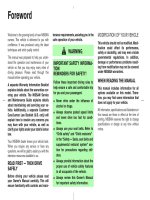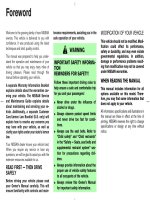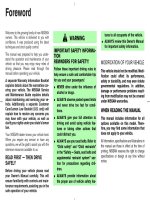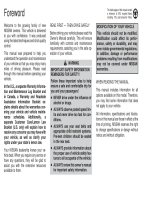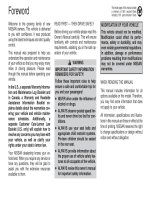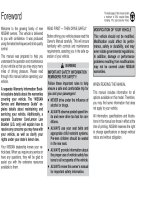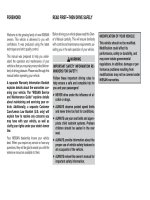NISSAN SENTRA 2013 OWNER MANUAL - SÁCH HƯỚNG DẪN SỬ DỤNG XE NISSAN SENTRA ĐỜI 2013
Bạn đang xem bản rút gọn của tài liệu. Xem và tải ngay bản đầy đủ của tài liệu tại đây (3.99 MB, 368 trang )
®
2013 SENTRA
OWNER’S MANUAL
For your safety, read carefully and keep in this vehicle.
2013 NISSAN SENTRA B17-D
B17-D
Printing : August 2012 (3)
Publication No.: OM2E 0B16U3
Printed in U.S.A.
OM3E 0B17U0
Welcome to the growing family of new NISSAN
owners. This vehicle is delivered to you with
confidence. It was produced using the latest
techniques and strict quality control.
This manual was prepared to help you under-
stand the operation and maintenance of your
vehicle so that you may enjoy many miles (kilome-
ters) of driving pleasure. Please read through this
manual before operating your vehicle.
A separate Warranty Information Booklet
explains details about the warranties cov-
ering your vehicle. The “NISSAN Service
and Maintenance Guide” explains details
about maintaining and servicing your ve-
hicle. Additionally, a separate Customer
Care/Lemon Law Booklet (U.S. only) will
explain how to resolve any concerns you
may have with your vehicle, as well as
clarify your rights under your state’s lemon
law.
Your NISSAN dealership knows your vehicle
best. When you require any service or have any
questions, they will be glad to assist you with the
extensive resources available to them.
In addition to factory installed options, your ve-
hicle may also be equipped with additional ac-
cessories installed by NISSAN or by your
NISSAN dealer prior to delivery. It is important
that you familiarize yourself with all disclosures,
warnings, cautions and instructions concerning
proper useof such accessories prior to operating
the vehicle and/or accessory. See a NISSAN
dealer for details concerning the particular ac-
cessories with which your vehicle is equipped.
Before driving your vehicle, please read this
Owner’s Manual carefully. This will ensure famil-
iarity with controls and maintenance require-
ments, assisting you in the safe operation of your
vehicle.
WARNING
IMPORTANT SAFETY INFORMATION RE-
MINDERS FOR SAFETY!
Follow these important driving rules to
help ensure a safe and comfortable trip
for you and your passengers!
● NEVER drive under the influence of al-
cohol or drugs.
● ALWAYS observe posted speed limits
and never drive too fast for conditions.
●
ALWAYS give your full attention to driving
and avoid using vehicle features or taking
other actions that could distract you.
●
ALWAYS use your seat belts and appro-
priate child restraint systems. Preteen
children should be seated in the rear seat.
● ALWAYS provide information about the
proper use of vehicle safety features to
all occupants of the vehicle.
● ALWAYS review this Owner’s Manual
for important safety information.
FOREWORD READ FIRST—THEN DRIVE SAFELY
MODIFICATION OF YOUR VEHICLE
This vehicle should not be modified.
Modification could affect its
performance, safety or durability, and
may even violate governmental
regulations. In addition, damage or per-
formance problems resulting from modi-
fications may not be covered under
NISSAN warranties.
This manual includes information for all options
available on this model. Therefore, you may find
some information that does not apply to your
vehicle.
All information, specifications and illustrations in
this manual are those in effect at the time of
printing. NISSAN reserves the right to change
specifications or design without notice and with-
out obligation.
IMPORTANT INFORMATION ABOUT
THIS MANUAL
You will see various symbols in this manual. They
are used in the following ways:
WARNING
This is used to indicate the presence of a
hazard that could cause death or serious
personal injury. To avoid or reduce the
risk, the procedures must be followed
precisely.
CAUTION
This is used to indicate the presence of a
hazard that could cause minor or moder-
ate personal injury or damage to your ve-
hicle. To avoid or reduce the risk, the pro-
cedures must be followed carefully.
If you see this symbol, it means “Do not do this”
or “Do not let this happen.”
If you see a symbol similar to these in an illustra-
tion, it means the arrow points to the front of the
vehicle.
Arrows in an illustration that are similar to these
indicate movement or action.
Arrows in an illustration that are similar to these
call attention to an item in the illustration.
APD1005
WHEN READING THE MANUAL
CALIFORNIA PROPOSITION 65
WARNING
WARNING
Engine exhaust, some of its constituents,
and certain vehicle components contain
or emit chemicals known to the State of
California to cause cancer and birth de-
fects or other reproductive harm. In addi-
tion, certain fluids contained in vehicles
and certain products of component wear
contain or emit chemicals known to the
State of California to cause cancer and
birth defects or other reproductive harm.
CALIFORNIA PERCHLORATE
ADVISORY
Some vehicle parts, such as lithium batteries,
may contain perchlorate material. The fol-
lowing advisory is provided: “Perchlorate
Material – special handling may apply, See
www.dtsc.ca.gov/hazardouswaste/perchlorate/”.
BLUETOOTH® is a
trademark owned by
Bluetooth SIG, Inc.
and licensed to
Visteon and Bosch.
SiriusXM Satellite
Radio requires sub-
scription, sold sepa-
rately. Not available
in Alaska, Hawaii or
Guam. For more
information, visit
www.siriusxm.com.
© Nissan Mexicana, S. A. de C. V.
All rights reserved. No part of this Owner’s
Manual may be reproduced or stored in a retrieval
system, or transmitted in any form, or by any
means, electronic, mechanical, photocopying,
recording or otherwise, without the prior written
permission of Nissan Mexicana, S. A. de C. V.
NISSAN CARES
Both NISSAN and your NISSAN dealer are dedicated to serving all your automotive needs. Your satisfaction with your vehicle and your NISSAN dealer are
our primary concerns. Your NISSAN dealer is always available to assist you with all your automobile sales and service needs.
However, if there is something that your NISSAN
dealer cannot assist you with or you would like to
provide NISSAN directly with comments or
questions, please contact the NISSAN Con-
sumer Affairs Department using our toll-free
number:
For U.S. customers
1-800-NISSAN-1
(1-800-647-7261)
For Canadian customers
1-800-387-0122
The Consumer Affairs Department will ask for the
following information:
– Your name, address, and telephone number
– Vehicle identification number (attached to the
top of the instrument panel on the driver’s
side)
– Date of purchase
– Current odometer reading
– Your NISSAN dealer’s name
– Your comments or questions
OR
You can write to NISSAN with the information at:
For U.S. customers
Nissan North America, Inc.
Consumer Affairs Department
P.O. Box 685003
Franklin, TN 37068-5003
or via e-mail at:
For Canadian customers
Nissan Canada Inc.
5290 Orbitor Drive
Mississauga, Ontario L4W 4Z5
or via e-mail at:
If you prefer, visit us at:
www.nissanusa.com (for U.S. customers) or
www.nissan.ca (for Canadian customers)
We appreciate your interest in NISSAN and thank you for buying a quality NISSAN vehicle.
NISSAN CUSTOMER CARE PROGRAM
Table of
Contents
Illustrated table of contents
Safety—Seats, seat belts and supplemental restraint system
Instruments and controls
Pre-driving checks and adjustments
Monitor, climate, audio, phone and voice recognition systems
Starting and driving
In case of emergency
Appearance and care
Maintenance and do-it-yourself
Technical and consumer information
Index
0
1
2
3
4
5
6
7
8
9
10
0 Illustrated table of contents
Air bags, seat belts and child restraints 0-2
Exterior front 0-3
Exterior rear 0-4
Passenger compartment 0-5
Instrument panel 0-6
Engine compartment check locations 0-7
Warning/indicator lights 0-8
1. Top tether anchor (P. 1-30)
2. Rear seat belts (P. 1-8)
3. Roof-mounted curtain side-impact
supplemental air bag (P. 1-34)
4. Head restraints (P. 1-5)
5. Front seat belts (P. 1-8)
6. Supplemental front-impact air bags
(P. 1-34)
7. Front seats (P. 1-2)
8. Occupant classification sensor
(weight sensor) (P. 1-41)
9. Seat belt with pretensioner (P. 1-34)
10. Front seat-mounted side-impact
supplemental air bag (P. 1-34)
11. Rear seats (P. 1-4)
12. LATCH (Lower Anchors and Tethers for
CHildren) system (P. 1-18)
See the page number indicated in paren-
theses for operating details.
LII2057
AIR BAGS, SEAT BELTS AND CHILD
RESTRAINTS
0-2 Illustrated table of contents
1. Engine hood (P. 3-22)
2. Windshield wiper and washer switch
(P. 2-24), Windshield (P. 8-18)
3. Moonroof (if so equipped) (P. 2-41)
4. Power windows (P. 2-38)
5. Door locks, keyfob (if so equipped),
keys, NISSAN Intelligent Key®
(if so equipped) (P. 3-4, 3-2, 3-2, 3-2)
6. Mirrors (P. 3-28)
7. Tire pressure (P. 8-30)
8. Flat tire (P. 6-3)
9. Tire chains (P. 8-37)
10. Replacing bulbs (P. 8-26)
11. Headlight and turn signal switch
(P. 2-26)
12. Fog light switch (if so equipped)
(P. 2-26)
13. Tie down hook (if so equipped)
(P. 6-14)
See the page number indicated in paren-
theses for operating details.
LII2054
EXTERIOR FRONT
Illustrated table of contents 0-3
1. Trunk lid (P. 3-23)
2. High mount stop light (P. 8-26)
3. Replacing bulbs (P. 8-26)
4. Rear window defroster switch (P. 2-25)
5. Child safety rear door lock (P. 3-6)
6. Fuel-filler door (P. 3-24), Fuel-filler cap,
fuel recommendation (P. 3-24, P. 9-3)
7. Rear view camera (if so equipped)
(P. 4-9)
8. Exterior trunk lid release
(if so equipped) (P. 3-16), Interior trunk
lid release (if so equipped) (P. 3-23)
See the page number indicated in paren-
theses for operating details.
LII2052
EXTERIOR REAR
0-4 Illustrated table of contents
1. Grocery hook (P. 2-36)
2. Interior lights (if so equipped) (P. 2-43)
3. Power window switch, Power door lock
switch (P. 2-38, 3-6)
4. Sun visors (P. 3-27)
5. Moonroof switch (if so equipped)
(P. 2-41)
6. Map lights (P. 2-44)
7. Sunglasses holder (P. 2-33)
8. Rearview mirror (P. 3-28)
9. Rear armrest, cup holders
(P. 1-4, P 2-34)
10. Console box (P. 2-36)
11. Front cup holders (P. 2-34)
LII2053
PASSENGER COMPARTMENT
Illustrated table of contents 0-5
1. Headlight/fog light (if so equipped)/turn
signal switch (P. 2-26)
2. Steering wheel switch for trip
computer, audio control and
Bluetooth® Hands-Free Phone System
(if so equipped) (P. 4-65, 4-67, 4-82)
3. Driver’s supplemental air bag/Horn
(P. 1-41, 2-29)
4. Meters and gauges (P. 2-3)
5. Cruise control main/set switches
(if so equipped) (P. 5-24)
6. Windshield wiper/washer switch
(P. 2-24)
7. Ventilator (P. 4-15)
8. Hazard warning flasher switch (P. 6-2)
9. Audio system (P. 4-26)
10. Passenger’s supplemental air bag
(P. 1-41)
11. Glove box (P. 2-36)
12. Shift selector (P. 5-17)
13. Climate control (P. 4-15, 4-23)
14. Ignition switch (if so equipped) (P. 5-8)
15. Tilt steering (P.3-26)
16. Hood release (P. 3-22)
17. Fuel filler door release (P. 3-24)
18. ECO mode switch (if so equipped)
(P. 5-23); SPORT mode switch (if so
equipped) (P.5-22); Vehicle dynamic
control (VDC) OFF switch (P.2-31)
19. Instrument brightness control (P. 2-28);
Power mirror switch (if so equipped)
(P.3-29); Trunk release (P.3-23)
* Refer to the separate Navigation System Own-
er’s Manual (if so equipped).
See the page number indicated in paren-
theses for operating details.
LIC2439
INSTRUMENT PANEL
0-6 Illustrated table of contents
MRA8DE engine
1. Engine oil filler cap (P. 8-9)
2. Brake and clutch (if so equipped) fluid
reservoir (P. 8-12)
3. Air cleaner (P. 8-17)
4. Battery (P. 8-13)
5. Fuse/fusible link box (P. 8-20)
6. Engine coolant reservoir (P. 8-7)
7. Radiator cap (P. 8-7)
8. Engine oil dipstick (P. 8-9)
9. Drive belt location (P. 8-16)
10. Windshield-washer fluid reservoir
(P. 8-12)
LDI2166
ENGINE COMPARTMENT CHECK
LOCATIONS
Illustrated table of contents 0-7
Warning
light
Name Page
or
Anti-lock Braking
System (ABS) warn-
ing light
2-13
or
Brake warning light 2-13
Charge warning light 2-14
Door open warning
light
2-14
Engine oil pressure
warning light
2-14
Low fuel warning
light
2-14
Warning
light
Name Page
Low tire pressure
warning light
2-14
Low windshield-
washer fluid warning
light
2-16
NISSAN Intelligent
Key® lock warning
light (M/T models) (if
so equipped)
2-16
NISSAN Intelligent
Key® warning light
(if so equipped)
2-16
P position selecting
warning light (CVT
models) (if so
equipped)
2-16
Power steering
warning light
2-16
Warning
light
Name Page
Seat belt warning
light and chime
2-17
Supplemental air
bag warning light
2-17
Indicator
light
Name Page
Continuously Vari-
able Transmission
(CVT) position indi-
cator light (CVT
models)
2-18
Cruise main switch
indicator light (if so
equipped)
2-18
ECO drive indicator
light
2-18
Engine start opera-
tion indicator light (if
so equipped)
2-18
WARNING/INDICATOR LIGHTS
0-8 Illustrated table of contents
Indicator
light
Name Page
Front fog light indi-
cator light (if so
equipped)
2-18
Front passenger air
bag status light
2-18
High beam indicator
light (blue)
2-18
Malfunction Indica-
tor Light (MIL)
2-18
Overdrive off indica-
tor light (CVT mod-
els)
2-19
Security indicator
light
2-19
Side light and head-
light indicator light
(green)
2-19
Indicator
light
Name Page
Slip indicator light 2-19
SPORT mode indi-
cator light (if so
equipped)
2-20
Turn signal/hazard
indicator lights
2-20
Vehicle Dynamic
Control (VDC) off
indicator light
2-20
Illustrated table of contents 0-9
MEMO
0-10 Illustrated table of contents
1 Safety—Seats, seat belts and
supplemental restraint system
Seats . 1-2
Front manual seat adjustment 1-2
Folding rear seat 1-4
Head restraints 1-5
Seat belts 1-8
Precautions on seat belt usage 1-8
Pregnant women 1-11
Injured persons 1-11
Three-point type seat belt with retractor 1-11
Seat belt extenders 1-14
Seat belt maintenance 1-14
Child safety 1-15
Infants 1-15
Small children 1-16
Larger children 1-16
Child restraints 1-16
Precautions on child restraints 1-16
LATCH (Lower Anchors and Tethers for
CHildren) System 1-18
Rear-facing child restraint installation using
LATCH 1-20
Rear-facing child restraint installation using
the seat belts . . 1-22
Forward-facing child restraint installation
using LATCH. . . 1-25
Forward-facing child restraint installation
using the seat belts 1-27
Installing top tether strap 1-30
Booster seats 1-30
Supplemental restraint system 1-34
Precautions on supplemental restraint
system 1-34
Supplemental air bag warning labels 1-49
Supplemental air bag warning light 1-49
WARNING
● Do not ride in a moving vehicle when
the seatback is reclined. This can be
dangerous. The shoulder belt will not
be against your body. In an accident,
you could be thrown into it and receive
neck or other serious injuries. You
could also slide under the lap belt and
receive serious internal injuries.
● For the most effective protection when
the vehicle is in motion, the seat should
be upright. Always sit well back in the
seat with both feet on the floor and
adjust the seat properly. See “Precau-
tions on seat belt usage” later in this
section.
● After adjustment, gently rock in the seat
to make sure it is securely locked.
● Do not leave children unattended inside
the vehicle. They could unknowingly ac-
tivate switches or controls. Unattended
children could become involved in seri-
ous accidents.
● The seatback should not be reclined
any more than needed for comfort. Seat
belts are most effective when the pas-
senger sits well back and straight up in
the seat. If the seatback is reclined, the
risk of sliding under the lap belt and
being injured is increased.
CAUTION
When adjusting the seat positions, be
sure not to contact any moving parts to
avoid possible injuries and/or damage.
FRONT MANUAL SEAT
ADJUSTMENT
ARS1152
SEATS
1-2 Safety—Seats, seat belts and supplemental restraint system
Forward and backward
Pull the center of the bar up and hold it while you
slide the seat forward or backward to the desired
position. Release the bar to lock the seat in
position.
Reclining
To recline the seatback, pull the lever up and lean
back. To bring the seatback forward, pull the lever
up and lean your body forward. Release the lever
to lock the seatback in position.
The reclining feature allows adjustment of the
seatback for occupants of different sizes for
added comfort and to help obtain proper seat
belt fit. See “Precautions on seat belt usage” later
in this section. Also, the seatback can be reclined
to allow occupants to rest when the vehicle is
stopped and the shift selector (CVT) is in P (Park)
or the manual transmission is in N (Neutral) with
the parking brake applied.
Seat lifter (driver’s seat)
Pull up or push down the adjusting lever to adjust
the seat height until the desired position is
achieved.
WRS0719 WRS0720 WRS0721
Safety—Seats, seat belts and supplemental restraint system 1-3
FOLDING REAR SEAT
Pull the knob
᭺
A
to fold each seatback down.
WARNING
● Never allow anyone to ride in the cargo
area or on the rear seat when it is in the
fold-down position. Use of these areas
by passengers without proper restraints
could result in serious injury in an acci-
dent or sudden stop.
● Properly secure all cargo with ropes or
straps to help prevent it from sliding or
shifting. Do not place cargo higher than
the seatbacks. In a sudden stop or col-
lision, unsecured cargo could cause
personal injury.
● When returning the seatbacks to the
upright position, be certain they are
completely secured in the latched posi-
tion. If they are not completely secured,
passengers may be injured in an acci-
dent or sudden stop.
● Closely supervise children when they
are around cars to prevent them from
playing and becoming locked in the
trunk where they could be seriously in-
jured. Keep the car locked, with the rear
seatback and trunk lid securely latched
when not in use, and prevent children’s
access to car keys.
Center armrest
Pull the armrest down until it rests on the seat
cushion.
LRS2194 LRS2217
1-4 Safety—Seats, seat belts and supplemental restraint system
HEAD RESTRAINTS
WARNING
Head restraints supplement the other ve-
hicle safety systems. They may provide
additional protection against injury in cer-
tain rear end collisions. Adjust the head
restraints properly, as specified in this
section. Check the adjustment after
someone else uses the seat. Do not attach
anything to the head restraint stalks or
remove the head restraint. Do not use the
seat if the head restraint has been re-
moved. If the head restraint was removed,
reinstall and properly adjust the head re-
straint before an occupant uses the seat-
ing position. Failure to follow these in-
structions can reduce the effectiveness of
the head restraints. This may increase the
risk of serious injury or death in a
collision.
The illustration shows the seating positions
equipped with head restraints. All of the head
restraints are adjustable.
᭡ Indicates the seating position is equipped with
a head restraint.
Components
1. Head restraint
2. Adjustment notches
3. Lock knob
4. Stalks
LRS0893 LRS2197
Safety—Seats, seat belts and supplemental restraint system 1-5
Adjustment
Adjust the head restraint so the center is level
with the center of the seat occupant’s ears.
To raise the head restraint, pull it up. To lower, push and hold the lock knob and push
the head restraint down.
WRS0134 LRS2198 LRS2199
1-6 Safety—Seats, seat belts and supplemental restraint system
Removal
Use the following procedure to remove the ad-
justable head restraints.
1. Pull the head restraint up to the highest
position.
2. Push and hold the lock knob.
3. Remove the head restraint from the seat.
4. Store the head restraint properly so it is not
loose in the vehicle.
5. Reinstall and properly adjust the head re-
straint before an occupant uses the seating
position.
Install
1. Align the head restraint stalks with the holes
in the seat. Make sure the head restraint is
facing the correct direction. The stalk with
the adjustment notches
᭺
1
must be installed
in the hole with the lock knob
᭺
2
.
2. Push and hold the lock knob and push the
head restraint down.
3. Properly adjust the head restraint before an
occupant uses the seating position.
LRS2200 LRS2201
Safety—Seats, seat belts and supplemental restraint system 1-7
PRECAUTIONS ON SEAT BELT
USAGE
If you are wearing your seat belt properly ad-
justed and you are sitting upright and well back in
your seat with both feet on the floor, your chances
of being injured or killed in an accident and/or the
severity of injury may be greatly reduced.
NISSAN strongly encourages you and all of your
passengers to buckle up every time you drive,
even if your seating position includes a supple-
mental air bag.
Most U.S. states and Canadian provinces
or territories specify that seat belts be worn
at all times when a vehicle is being driven.
SSS0136
SEAT BELTS
1-8 Safety—Seats, seat belts and supplemental restraint system

